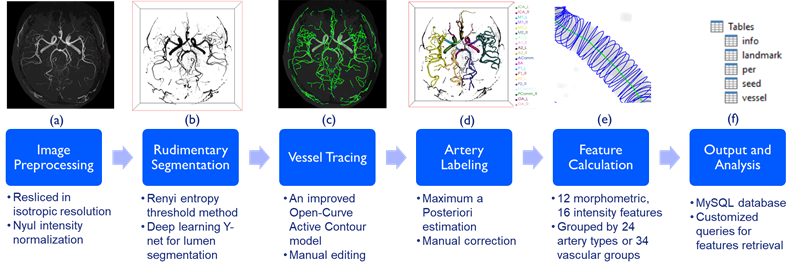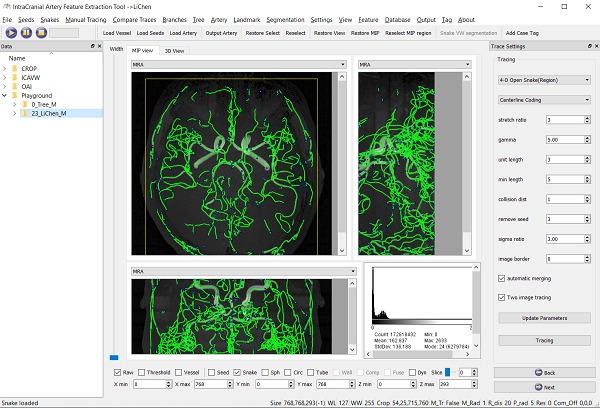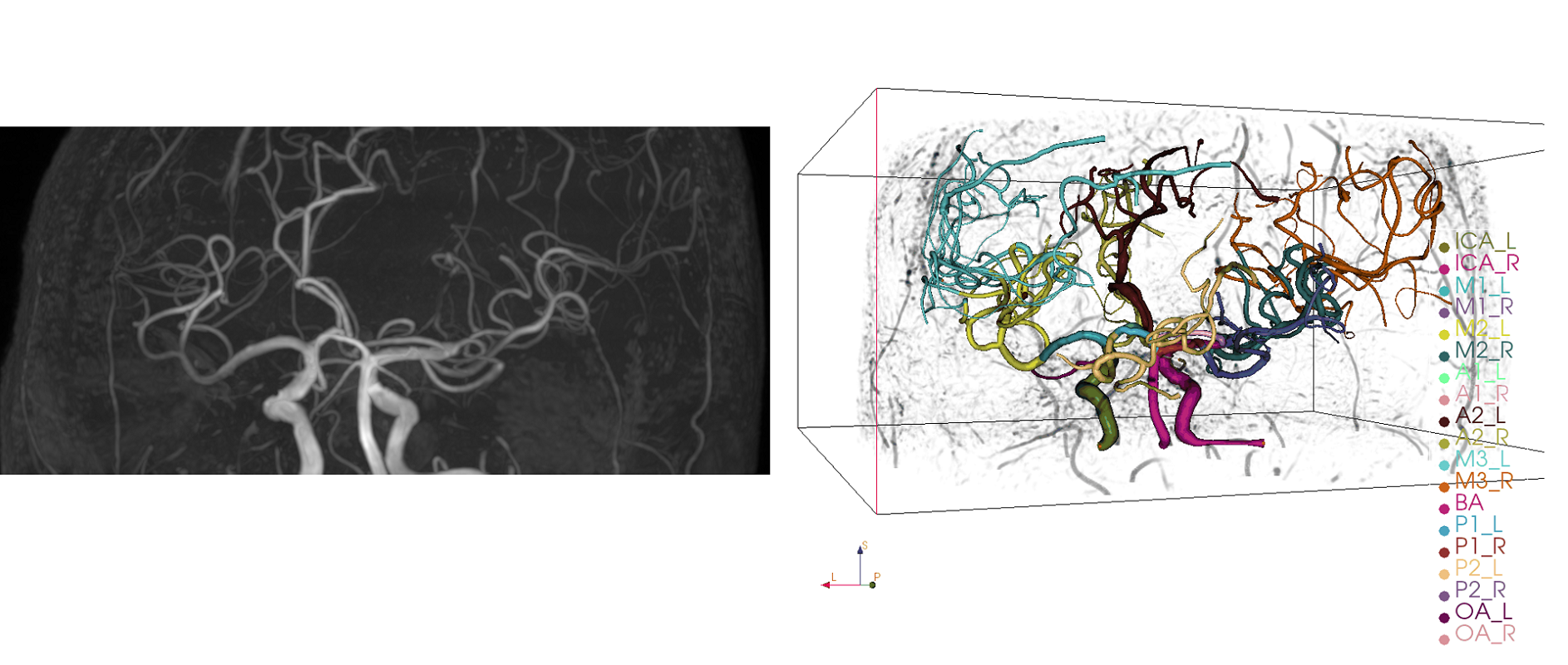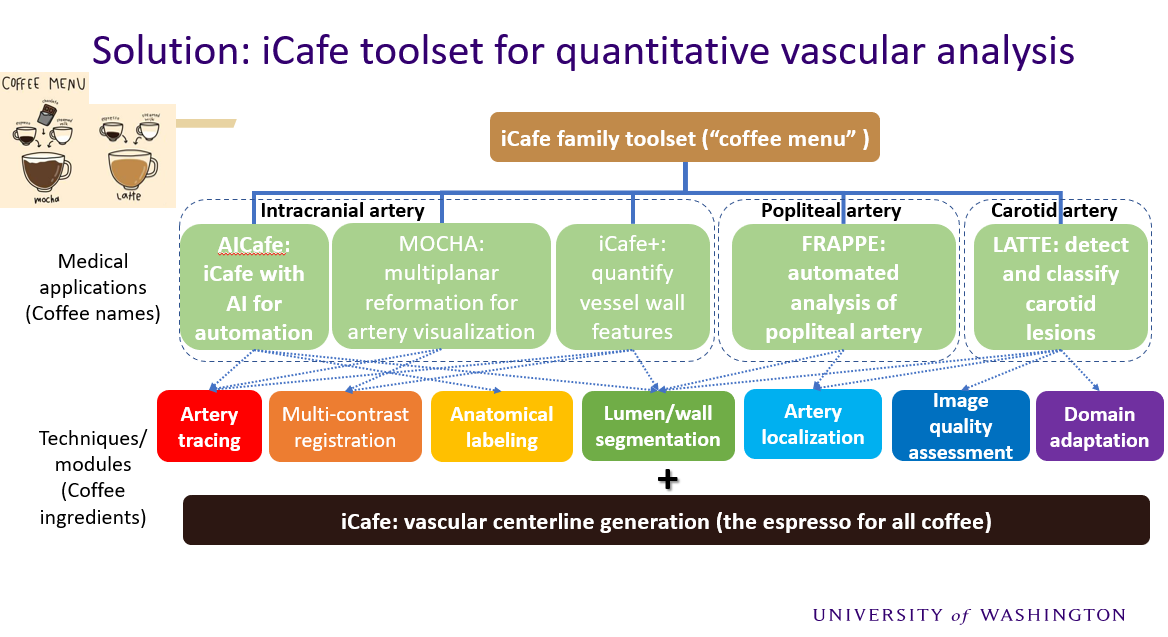IntraCranial Artery Feature Extraction (iCafe) of Vascular Biomarkers for Assessing Cerebral Vessel Health
Vascular structure and function play a crucial role in maintaining brain health. To comprehensively quantify intracranial artery features, a semi-autumated artery modeling tool (iCafe) was developed to analyze arteries from 3D vascular images, such as 3D Time-of-flight MRA.
Technical developments
The technical development of iCafe was described in the MRM paper. In summary, iCafe (intraCranial artery feature extraction, previous name: BAFET) was built by incorporating and developing multiple vascular image processing modules, such as the centerline tracing algorithm (Open curve active contour [Wang, ICCV, 2011] from the Farsight toolbox, the comprehensive and convenient trace editing operations, the artery anatomical labeling scheme for intracranial artery segments [Chen, MICCAI, 2020], the automated vascular segmentation and analysis framework [Chen, arXiv, 2019], and the visualization platform to view vascular structures in multiple ways [Chen, ISMRM, 2020].
Workflow
isotropic reslicing and intensity normalization
(optional) rudimentary segmentation to reduce noise
Artery tracing using the open curve active contour model, with manual correction of tracing errors
Artery anatomical labeling (so that we can get regional divisions of cerebral circulation)
Feature extraction from the artery traces (represented as radius varying tubes)
Saving results in MySQL database for further statistical analysis

Workflow for intraCranial artery feature extraction (iCafe)
What is special for iCafe compared with other tools for quantifying arteries:
1. Comprehensive features including topology and intensity in each anatomical region of cerebral artery circulation can be extracted.
Topology
Vessel areas need to be segmented first, then convert the vessel areas to tree-like structures. After that, several features can be calculated, such as total voxel of vessels in the brain, length of branches, number of end points in tree, proportion of main branch and small end branch, etc. The richness and intricacy of vessels are essential in evaluating brain health.
Intensity
Gray scale of each voxel in TOF is related with flow speed of blood according to the MR imaging principle. MR intensity cannot be directly used, as the intensity values do not have a physical meaning. A simple but effective image normalization method (Nyul method) is used to make samples in a dataset to be comparable in intensity. The normalized data is then used to reflecting blood flow, another important metric for assessment of cerebral vascular health.
Region division
Vessel aging may appear in different regions of brain on different scales. Intracranial artery tree is divided to have a better understanding of which part of brain vessel is more likely to change during aging. A simple method based on determining "Order" is used to separate vessels into four groups. More complete artery tree division is also available if several bifurcation of interest points are assigned with anatomical labels. Artery definition used in iCafe can be found here.
With all features coming from different grouping methods, a total of 1,456 features can be extracted from each case described in the paper. Actually with the recent development, we can extract more features, such as artery density and boundary sharpness.

iCafe loaded with my brain MRA scan. Luckily I still have complete Circle of Willis.
2. High accuracy due to the semi-automated processing
The design concept for iCafe is using more manual edits to ensure higher quantification quality.
Using iCafe might be time consuming, but the quality of artery traces can be ensured, thus the vascular features have reliable qualities.
From the experiments in the MRM paper, iCafe shows 94% sensitivity and 85% precision in bifurcation detection, 0.328±0.444mm in bifurcation deviations, which is within pixel spacing. The length measurement is close to measurement from the Philips workstation, with a correlation coefficient of 0.97.
Meanwhile, the high quality labels can be used as perfect labels for various machine learning projects, such as luminal area segmentation and artery anatomical labeling.

3D view of iCafe processed vasculature tree
Click here for 360 degree animation (92MB)
3. Extensible to other artery analysis tasks
iCafe, with its further development, has become the base platform to support multiple artery analysis tasks. Such as multiple view of artery, comparing arteries in multiple time points, visualization of segments predicted with high risk lesions. Enlighted from the iCafe naming, the following up packages are all named after cafe and coffee, like MOCHA, LATTE, FRAPPE. The iCafe family

iCafe family for comprehensive artery analysis
Validations
MRA such as 3D TOF is susceptible to noise and flow impacts. It is unknown whether the artery structure and intensity information from TOF are reliable for vascular quantification and analysis. In addition, as a semi-automated tool, its inter-rater reproducibility requires validation. So we have selected subjects with repeated scans within 2 weeks to test the inter-scan, inter and intra operator reproducibility. Details in the MRI paper.
Medical applications
After validation, we can apply iCafe on various medical and clinical problems. The original intention of building iCafe was for the aging project (paper) on analyzing vessel features among a comunity group with various ages. But iCafe is also showing great potentials on more applications with its continuous development, such as finding artery differences in dimentia group, comparing different sequences, observing artery changes before and after treatment.
An incomplete list of iCafe related publications:
Journal papers:
Development and validation of iCafe: http://clatfd.cn/a/233
Reproducibility assessment and TOF reliability validation: http://clatfd.cn/a/243
iCafe application on aging study: http://clatfd.cn/a/248
iCafe applied to compare novel MR sequence: DOI: 10.1016/j.mri.2019.09.001
Challenging arteries refinement: http://clatfd.cn/a/300
Vascular features from TOF validated with ASL for flow change: DOI: 10.1016/j.mri.2020.10.004
Uncontrolled hypertension associates with subclinical cerebrovascular health: DOI: 10.1007/s00330-020-07218-5
Endothelial Function and Intracranial Vascular Health: DOI: 10.1177/0271678X20956950
Vessel length on SNAP MRA and TOF MRA is a potential imaging biomarker for brain blood flow: DOI: 10.1016/j.mri.2021.02.012
Conference publications:
Lumen segmentation using deep learning: http://clatfd.cn/a/236
Artery centerline and radius refinement: http://clatfd.cn/a/261
Monitor change before and after carotid revascularization: ![]() ISMRM2019_Arizona.pdf
ISMRM2019_Arizona.pdf
Quantitative measurement of peripheral arteries: ![]() ISMRM2019-pCafe.pdf
ISMRM2019-pCafe.pdf
Arterial collateralization comparison on peripheral artery disease: ![]() ISMRM2019_PAD.pdf
ISMRM2019_PAD.pdf
Vascular analysis on dementia subjects with controls: ![]() ISMRM2019_ACT.pdf
ISMRM2019_ACT.pdf
Artery reformation and visualization: ![]() ISMRM2020_MOCHA.pdf
ISMRM2020_MOCHA.pdf ![]() ISMRM2020_MOCHA-morphological.pdf
ISMRM2020_MOCHA-morphological.pdf
Automated artery labeling using graph neural network: http://clatfd.cn/a/305
Download:
iCafe is currently a research tool for academic uses only. Please contact our lab manager Dr. Gador Canton (gcanton@uw.edu) if you are are interested and planning to use it for academic purpose. Please also attach a brief introduction of your group and what you want to do using iCafe in the email. If you did not hear from them for three business days, please let current maintainer Xin Wang (xwang99@uw.edu) or me (cluw@uw.edu) know.
Note that we are not being able to give technical support for iCafe currently. Please read the guide and watch demo video carefully if you want to use it.
User guide:
https://1drv.ms/w/s!AqZ4RxQg6dp-7XX7_yu1jXxpSbg7
You can edit this shared document with track change mode if you find something I have not mentioned. Also welcome your comments, bug reports, feature suggestions, etc in this online document.
iCafe demo by Li Chen on Youtube playlist:
https://www.youtube.com/playlist?list=PLxG3HeAddxYb_KQbL2fKNV5BW99yMCksY
Current newest version: V1.4.4.4, released on 4/14/2020